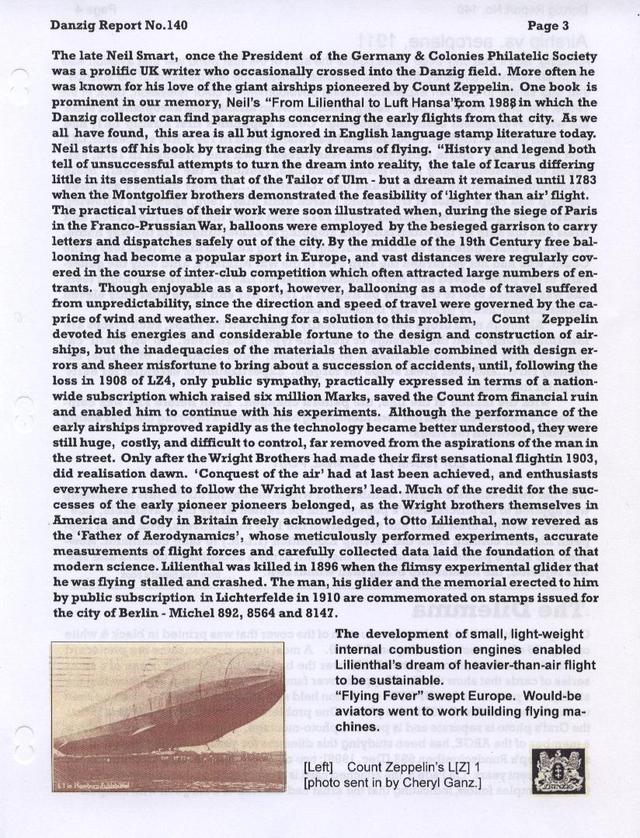
>> 2008 ... Another Danzig Year.
The late Neil Smart, once the President of the Germany & Colonies Philatelic Society was a prolific UK writer who occasionally crossed into the Danzig field. More often he was known for his love of the giant airships pioneered by Count Zeppelin. One book is prominent in our memory, Neil's "From Lilienthal to Luft Hansa" from 1988 in which the Danzig collector can find paragraphs concerning the early flights from that city. As we all have found, this area is all but ignored in English language stamp literature today. Neil starts off his book by tracing the early dreams of flying. "History and legend both tell of unsuccessful attempts to turn the dream into reality, the tale of Icarus differing little in Its essentials from that of the Tailor of Ulm - but a dream it remained until 1783 when the Montgolfier brothers demonstrated the feasibility of 'lighter than air' flight. The practical virtues of their work were soon illustrated when, during the siege of Paris in the Franco - Prussian War, balloons were employed by the besieged garrison to carry letters and dispatches safely out of the city. By the middle of the 19th Century free ballooning had become a popular sport in Europe, and vast distances were regularly covered in the course of inter-club competition which often attracted large numbers of entrants. Though enjoyable as a sport, however, ballooning as a mode of travel suffered from unpredictability, since the direction and speed of travel were governed by the caprice of wind and weather. Searching for a solution to this problem, Count Zeppelin devoted his energies and considerable fortune to the design and construction of airships, but the inadequacies of the materials then available combined with design errors and sheer misfortune to bring about a succession of accidents, until, following the loss in 1908 of LZ4, only public sympathy, practically expressed in terms of a nationwide subscription which raised six million Marks, saved the Count from financial ruin and enabled him to continue with his experiments. Although the performance of the early airships Improved rapidly as the technology became better understood, they were still huge, costly, and difficult to control, far removed from the aspirations of the man in the street. Only after the Wright Brothers had made their first sensational flight in 1903, did realisation dawn. 'Conquest of the air' had at last been achieved, and enthusiasts everywhere rushed to follow the Wright brothers' lead. Much of the credit for the successes of the early pioneer pioneers belonged, as the Wright brothers themselves in America and Cody in Britain freely acknowledged, to Otto Lilienthal, now revered as the 'Father of Aerodynamics', whose meticulously performed experiments, accurate measurements of flight forces and carefully collected data laid the foundation of that modern science. Lilienthal was killed in 1896 when the flimsy experimental glider that he was flying stalled and crashed. The man, his glider and the memorial erected to him by public subscription in Lichterfelde in 1910 are commemorated on stamps issued for the city of Berlin - Michel 892, 8564 and 8147.
The development of small, light-weight internal combustion engines enabled Lilienthal's dream of heavier - than - air flight to be sustainable.
"Flying Fever" swept Europe. Wouldbe aviators went to work building flying machines.
[Left] Count Zeppelin's L[Z] 1 (photo sent in by Cheryl Ganz.]
Danzig Report 140, 2008, Page 3.
Hits: 4513
Added: 22/03/2008
Copyright: 2025 Danzig.org

